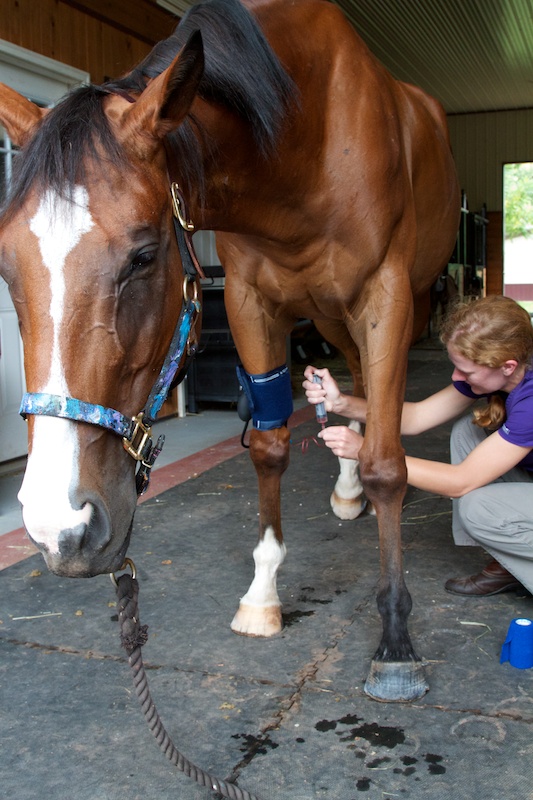Dr. Kimberly Brokaw, DVM, of Maryland announced this week that novel treatments introduced to counteract potentially life-threatening knee inflammation and arthritis in famous “painting” ex-racehorse Metro Meteor, appear to be working.
Metro, the talented ex-racehorse who paints abstract in acrylics, and who has been featured on myriad national news shows, suffers soft tissue swelling within the joint capsule of his knees, combined with an arthritic condition and extra bone growth, Brokaw explains.
His condition, which developed after multiple knee surgeries to remove bone chips, rendered him at the top level of a lameness scale. Brokaw explains: “The Lameness Scale is 0 through 5, with 5 being a fractured leg. Metro had been at a grade 4.”
The pain, which made him uncomfortable even in a pasture environment, was exacerbated by a development in Metro’s knees, making euthanasia a very real possibility in his future.
Metro was growing new bone in his knees to stabilize the area, a phenomenon common in horses who lose stability in a joint, Brokaw says. The problem was that the growth of the bone was impeding the flexibility of his knees, raising the risk that one day he would lose flexibility in his front legs, rendering him helpless.
“This is a very significant problem in horses because they need to be able to get back up after lying down, and if they can’t, we need to euthanize them,” Brokaw says.
Determined to give his beloved horse every chance at a long, pain-free life, owner Ron Krajewski teamed up with Brokaw, first taking the route of traditional medicines. But with only limited success, Brokaw decided to introduce a treatment that is not yet approved in the United States. And it appears to be saving his life!
About a year ago, Brokaw began injecting the site around Metro’s knees with Tildren, a bisphosphonate class of drugs that has shown remarkable promise in the treatment of other equine afflictions, including navicular disease and bone spavin.
But she had to be as creative in her methods as Metro has been in his painting.
Because the potent drug can cause kidney failure or colic in horses, she developed a method to apply it locally to the affected area, preventing it from entering his bloodstream and circulating into his organs.
By applying a tourniquet to his leg to temporarily arrest blood flow, (similar to the way that high-dose antibiotics is administered to horses), Brokaw has been able to give Metro what he needs, and still avoid overwhelming his system.
So far so good!
For the first time in a long time, Metro appears to be relatively pain free. On the Lameness Scale, he has been dropped from 4 to 2, and Krajewski can’t believe his eyes.
“One day, I turned Metro and our four-year-old Quarter Horse, Hotshot, out together in the outdoor arena. I wanted to get some photos and they always play and interact well together,” he says.
“They began running around the outdoor arena. Metro was trotting, cantering, galloping, and making sharp cuts chasing Hotshot around. He was bucking and kicking and jumping all over the place. I was amazed at how sound he looked!”
The once-noticeable limp wasn’t detectable, and after Brokaw declared Metro to be sound for riding, Krajewski and his wife Wendy began lightly riding him.
Further indication that the treatment is working was revealed in X rays, which show there is less inflammation in the joint, Brokaw says, noting that she is so encouraged by the results that she plans to write a veterinary science paper detailing her findings.
Metro, who garnered headlines for making acrylic paintings by holding a paint-dipped brush in his teeth and stroking it across a canvas, may soon make more news in the science community.
“This is the first time, I believe, that this treatment has been tried on the knee,” Brokaw says, adding, “I hope that we’ve bought him additional years of life.”
It is such a relief now for Krajewski to imagine that his beloved painting horse may live a long, happy life.
“I am extremely encouraged that Metro doesn’t have that death sentence hanging around his neck anymore,” he says. “I think we have a lot more years together ahead of us.”






This site will give you contact info for Dr Brokaw:
http://tinyurl.com/mpwbddm
Tildren, made by Ceva, is scheduled to launch as a new APPROVED drug in June. Please contact your vet about it.
We have a AQH mare with very bad knees. Would like to have her treated if possible. Need to have Dr. Kim Brokaw contact us about treatment.
I can speak from experience that the Tildren treatments, particularly when applied with tourniquet to direct the drug to the area needing fixing, is incredible. I have an OTTB who had joint injections off and on for about more than a dozen years. Two years ago he developed a lameness and radiographs showed a navicular that looked like swiss cheese. Two Tildren treatments (I always think, “Tildren to the bone,” like those “Omnaris to the nose!” commercials) and he is sound and happy and going very well.
Happy to know my guy has something in common with the VERY famous Metro!
Glad to see Metro running free. Congratulations to both Ron Krajewski and Dr. Brokaw on finding a successful treatment and the patience to not give up! Keep painting Metro!
A horse in my barn had this done a few weeks ago to address coffin joint arthritis. I am very curious to see if he improves. This is a cost effective treatment especially if it works as well as it has for the guy above!
How can I get a hold of this vet? I have one that might be a canidate for this.